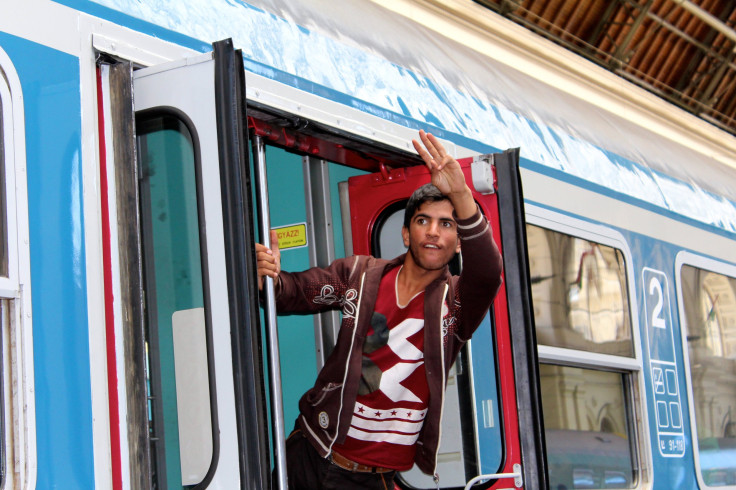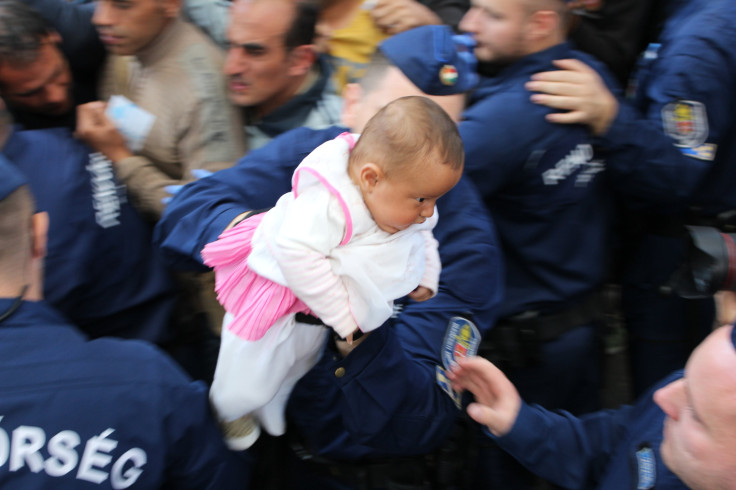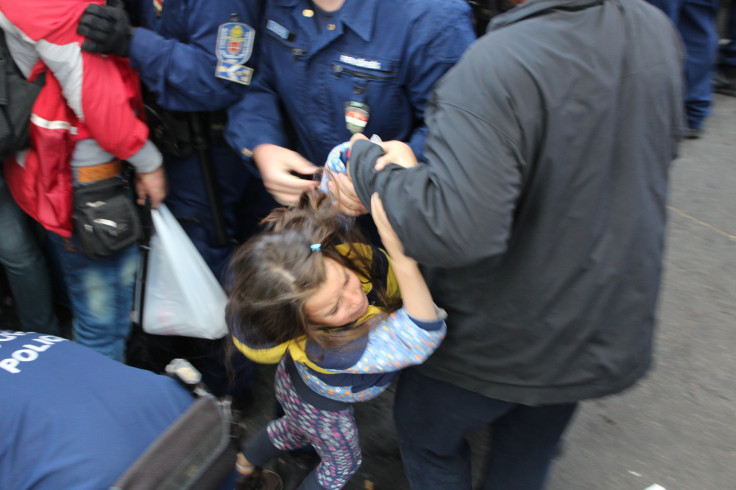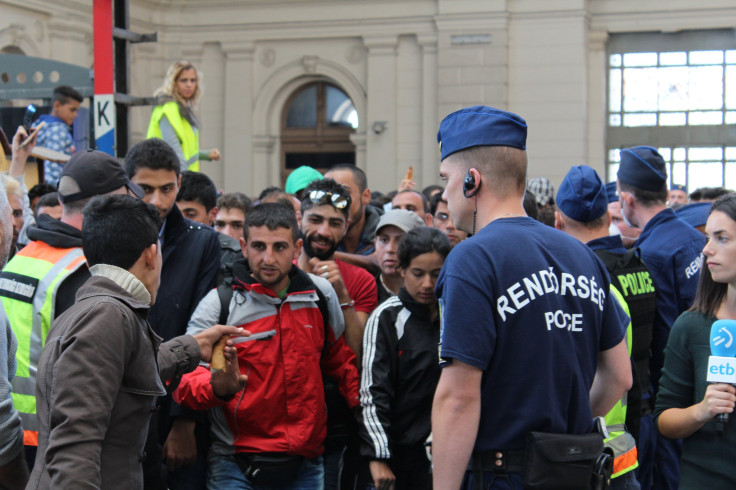Refugee Children: Hungarian Orphanages Overwhelmed With Minors Who Make Journey To Europe Alone

FOT, HUNGARY -- Weeping willows hang over the man-made lake at the children’s home in Fot, a town about 14 miles outside of Budapest. The smell of horse manure drifts through the air from the stables located down the dirt road on the other side of the complex. The sounds of children laughing and playing can be heard from behind the playground on the hill overlooking the lake, where elderly Hungarian men perch on wooden stools as they fish.
This complex hardly seems like a place that anyone, let alone a child, would want to leave. It has horses to ride, meadows and gardens to run in, and classrooms where they can learn. But for the children arriving in Hungary from the Middle East and North Africa, this home has become a place to flee from, not a refuge.
The children’s home went into crisis mode in May, flooded with refugee children, most of them teens, who have no guardians -- legally known as unaccompanied minors. Some of the children left their country of origin alone or with neighbors; others lost their parents along the way.
The home's employees in Fot were unable to provide basic services for the newcomers. Children slept on mattresses in hallways, food was scarce, and there were no translators who could tell the children arriving from places like Syria that they were safe. It took weeks to register children with local authorities and submit their applications for asylum.
In what has quickly become one of the worst humanitarian disasters in recent history, European countries are struggling to find the funding and resources to deal with the influx of refugees. One of the biggest and most costly tasks is tracking and integrating unaccompanied minors into local welfare systems in Europe. Because of the cost and the lack of standard practices, unaccompanied minors are often left in limbo without adequate shelter, medical services, and food. Without proper tracking and integration, unaccompanied minors are now, during the largest migration to the region since the end of World War II, at risk of falling into trafficking networks and other abusive systems.
The dysfunction at the Fot children's home has meant that after stays of about two weeks, hundreds of unaccompanied minors have left the facility (and probably the country) -- and no one can say where they've gone, according to a review of the home conducted by the United Nations and obtained by International Business Times. Their whereabouts are unknown and there is no one group, government, or institution tracking them. They are now officially “missing,” said Istvan Kadas, the executive director of the home.
The refugees, he said, are free to leave the complex at any time and are given a small booklet that says they are residents of the home. They can show it to officials if approached on the street. He said that he does not know precisely how the young refugees leave the complex, but they usually travel in groups and leave at night.
"We consider it a success when the refugee children come here and decide to stay,” Kadas said. “We don’t know where the others have gone to, but we can only pray they are okay.”
From June through July, the police in Hungary registered 1,397 unaccompanied minors, according to the UN Refugee Agency in Budapest. The children’s home in Fot received hundreds of those children, most of them from Afghanistan, Pakistan, Iraq and Syria. The two other children's homes in Hungary received smaller numbers. With an official capacity of only 34, the children’s home in Fot hosted up to 300 children at a time, according to the UN report. Management provided basics, including shelter and meals but did not have resources to provide more sophisticated resources or organized community activities.

Almost all of the minors left to make another perilous journey to Germany and Austria. Just 11 stayed behind.
"Sometimes they don't even wait until the authorities register them and give them the proper papers," Kadas said. "They don't want to be here. They would rather be with the group traveling to Germany and other places."
Kadas and the leaders of the unaccompanied minors program in Hungary worry that a new wave of refugees, expected to cross the Serbian border within the next week, will bring hundreds more unaccompanied minors that they do not have the capacity to manage.

Hungary isn’t the only country struggling to accommodate unaccompanied minors. In Italy and Malta, some 10,000 unaccompanied and separated children have arrived this year. In June alone, 4,270 children landed on the Greek islands; 86 of them were unaccompanied, according to Save the Children estimates. Since the beginning of the year in Serbia, authorities have registered 4,114 unaccompanied minors: 3,500 boys and 614 girls.
“People do not have an adequate place to sleep -- such as a tent -- and there is little in the way of washing facilities,” Kitty Arie, Save the Children's director of advocacy said in a statement in early August describing Greece’s conditions. She said there were not enough reception facilities to process not only the other adult refugees, but the unaccompanied minors as well. “Vulnerable children … are at risk of trafficking, sexual exploitation and physical abuse.”
The European refugee crisis is growing more dire by the week. Refugees are fleeing economic hardship and war from countries in North Africa and the Middle East. Combined, hundreds of thousands of people have crossed into the European Union (EU) since January. Common routes include the passage from Libya by boat to Greece and Italy and by boat from Turkey to Greece. And since the beginning of the year, some 102,000 migrants entered by land through western Balkan countries such as Macedonia, Serbia, Bosnia and Herzegovina, Montenegro and Albania.
The most vulnerable are the unaccompanied minors, but they are often the hardest to protect, activists say. Governments throughout the region do not have clear policies on how to handle the massive influx, especially during a time when several of the countries are dealing with economic downturns. Asylum systems in many countries are still not fully in conformity with international standards, according to the UN Refugee Agency.
“The practice for receiving unaccompanied minors is really decentralized. Each country has a different practice,” said Elona Bokshi of the European Council on Refugees and Exiles. Boshki is working on a project to identify best practices for receiving unaccompanied minors and integrating them into the local societies in Europe. “Some countries, like Hungary for example, say they don’t have the money to give unaccompanied minors everything that, for example, Sweden does.”
With no formal tracking system and little data, the number of missing unaccompanied minors that may have fallen into trafficking networks in Europe is unknown. The Hungarian government is doing little to help, let alone track, these children.

Hungary's response, instead, is to begin building a high fence along the country's southern border with Serbia; Hungarian officials have vowed new legislation to cut the number of migrants entering the country starting Sept. 15.
The parliament recently adopted legislation that allowed for the creation of at least three zones in a narrow strip along its border with Serbia that would serve as an area to process refugees. Each zone, though, "does not qualify, in immigration terms, as an entry into that state," Justice Minister Laszlo Trocsanyi said this week.
"Given that almost all of the asylum seekers in Hungary are coming through Serbia, in one fell swoop that would be rendering inadmissible nearly all of the asylum seekers that are coming into Hungary," Bill Frelick, Refugee Rights Programme Director at Human Rights Watch, told Reuters on Wednesday.
That means unaccompanied minors could, in theory, also be turned away by Hungary. Kadas said he does not know exactly how the transit zones will work, or if his organization will receive more refugees.
In the Fot home on Wednesday, Afghani boys attended a small classroom session to learn Hungarian. They, unlike the refugees who've fled, will learn how to speak Hungarian and will likely find work in the local community. Once they turn 18, though, they will have to leave the home and fend for themselves.
Sári Belecz contributed to this report.
© Copyright IBTimes 2024. All rights reserved.




















